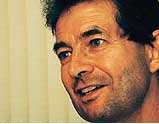
EDUARDO CESARMark Harvey: “Brazil gave the world a lesson”EDUARDO CESAR
With modest resources, compared with the Science and Technology budgets of the major scientific powers, and giving priority to areas that are strategic for the country, the state of São Paulo has created an inventive model for research into genomics and bioinformatics: FAPESP’s ONSA (Organization for the Sequencing and Analysis of Nucleotides) network. This model has put Brazil in a position of global leadership in two niches of this competitive sector: genomes of bacteria that attack plants (Xylella fastidiosa, Xanthomonas citri and Agrobacterium tumefaciens ) and of an important tropical farm crop (the Sucest project, with sugarcane).
The opinion comes from English sociologist Mark Harvey, from the Centre for Research on Innovation and Competition, of the University of Manchester. With his colleague Andy McMeekin, he decided to study the successful entry of Brazil into the scene of world genomics, from the point of view of international geopolitics. “Brazil has given the world a lesson. To start with, it chose a few areas that were not a priority for the developed countries and invested in these sectors”, explains Harvey, who was in São Paulo at the end of last month. “Without copying the North American model, the country developed its own paths, outside the major international research centers, which, in the long term may be important to put into equilibrium the development of science and technology among all the nations of the globe”.
The British researcher also praised Brazil’s participation, in work coordinated by the National Council for Scientific and Technological Development (CNPq), in the creation and development of the Leishmania Genome Network, a project of the World Health Organization (WHO) and the World Bank, which studies the parasite/host relationship for this tropical disease that affects 12 million persons. “Brazil is the only developing country taking part in this international consortium”, Harvey emphasizes.
International inclusion
For the sociologist, it was the setting up of the ONSA network in the state of São Paulo in 1997, as a virtual and decentralized consortium of 34 laboratories, that acted, without a doubt, as a springboard for the international inclusion of Brazilian genomics. The publication in Nature magazine, with a mention on the cover, of ONSA’s first job – the sequencing of Xylella fastidiosa, which causes Citrus Variegated Chlorosis (CVC), the yellowing disease that attacks the orange groves – showed that the strategy could be productive and competitive at the world level. The work on X. fastidiosa caused a great repercussion, because this bacterium was the first plant pathogen to have its DNA deciphered. “ONSA’s structure was an original way of redrawing the European network of laboratories that, in 1997, concluded, also in a decentralized way, the sequencing of the genome of Saccharomyces cerevisiae, the yeast used in fermentation”, says Harvey.
One of the points that impressed the British researcher is ONSA’s capacity for cooperation at several levels, inside and outside Brazil, and with public or private partners. “The bioinformatic tools developed by the State University of Campinas (Unicamp ), for example, were successfully employed by the University of Washington in the sequencing of A. tumefaciens (a bacterium with natural mechanisms for transferring genes to plants) and the data of the sugarcane genome attracted the attention of CropDesign, a Belgian biotechnology company”, says Harvey. He intends to give an account of the victorious Brazilian experience in genomics in lectures and scientific articles. “This shows a good strategy for setting up partnerships”.
Republish